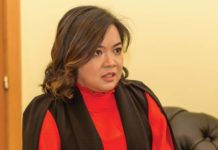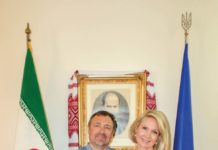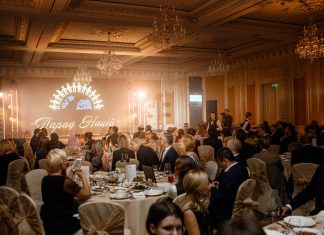You moved to Ukraine in 1995 with your family. What was your first impression?
– When I moved to Kyiv, Ukraine, with my husband in 1995, I was incredibly excited to connect with the country that I heard stories about my entire life. I was raised to understand that Ukraine was the country with its own distinct nationality. And even though I knew that the Soviet Union was russifying Ukraine, when I arrived in Kyiv and heard everyone speaking Russian, it was unsettling for me and I had a difficult time accepting it as my new home.
Over the last 23 years living mostly in Ukraine, I have connected closely with many Ukrainians. They have taught me that being Ukrainian is more than just speaking the language and staying true to traditions. It’s a deeper feeling of belonging to and caring for a nation that you call home. While working as an artist, as well as a psychotherapist, I realized that I have a responsibility to continue this battle for freedom of our minds, bodies, and souls.

What have prompted you to work with such a sensitive subject as ‘loss of identity’? As we understand, the exhibition of your paintings “Identity, interrupted” is devoted to this problem?
– Growing up in America, it was very natural for me to tell everyone that I was Ukrainian. My parents felt it was deeply important for us to learn the Ukrainian language, history and culture. The Ukrainian community was strong in all major cities.
My new series “Identity, Interrupted” stems from my personal story of growing up in the USA with a Ukrainian identity and how this identity was challenged when I actually began day to day life in a newly independent, 1990’s Ukraine.
You have a lot of paintings devoted to Ukrainian Maidan Events in 2004 and 2014. Did you participate in those events? What have impressed you most and inspired you?
– With a professional background in psychotherapy, I first took up painting during the 2004 Orange Revolution. Along with millions of others, I was consumed with the emotions of Ukraine’s first post-Soviet revolution. Painting was an emotional release for me, a way for me to express my feelings, and I found it to be therapeutic. Little I did know that it would prove to be a life changing experience for me and lead me to a new career as an exhibiting artist. As a psychotherapist, my job was to help people get to the truth beneath the surface as well as to explore deeper understanding of themselves in order to reveal the hidden feelings within.
“…Rondiak captures her own vision to broaden our grasp of human experience and resiliency to finding the freedom to live in a society that remembers it’s past…“
writes Kathrine Page, Gretchen Hupfel Curator of Contemporary Art at the Delaware Contemporary.

You popularize Ukraine in the world. Do you consider your mission as a cultural diplomacy?
– My art is heavily influenced by my family’s history as well as my own experience in life. The Ukraine that I was identifying with throughout my childhood was the one that my mother left at 11. She arrived in Ellis Island with my grandfather at 16. And while my mother and grandfather ended up as refugees in Austria at a “displaced people’s” camp, my grandmother was sent to a female labour camp in Mordovia (Russia). While she was there, after losing her family and home, she secretly created beautiful embroideries using fishbones for needles, potato sacks for canvas, and threads from her clothing. She managed to smuggle them out after being released and passing them on to a clandestine priest who was travelling to America. He then smuggled them into the states, where the Chicago Tribune wrote an article about them in 1980, and then they eventually found their home with my family.
My grandmother, her strength and tenacity, has become a great source of inspiration.
Although Ukraine is now fighting in a war with Russia in the east and dealing with the leftover corruption, it is well on its way to realizing itself as a true democracy. I have witnessed this transition with my own eyes and I think it is my responsibility to share this story, as it represents so many similar stories in Ukraine and gives a voice to millions of Ukrainians.
How do Americans without Ukrainian roots react to your paintings? Are they interested in what is happening in Ukraine?
– Growing up in America, I had “two lives,” my Ukrainian world and my American world. I was used to sharing my story with Americans and people in general were interested and curious.
From my experience, people didn’t really know what was happening in that part of the world.
You have worked on a mural painting in Kyiv. What fascinates you in street art genre?
– My involvement in the Art United Us mural project happened to be after a meeting with a project coordinator Geo Leros at the opening of my spring 2016 exhibition at America House in Kyiv. As a newcomer to the street art genre, I did not have to think long before accepting an invitation to contribute a mural. I was attracted to the idea of making something large and to be part of this community. I was offered many locations before finally choosing the wall in Borysohlibska Street 10th in Kyiv historic Podil district. I see the explosion of street art in Kyiv as a reflection of the new Ukraine. It is giving the city a far more contemporary feel and highlighting the social shift towards Europe that has been underway since the Revolution of Dignity in 2013–14.

In early 90s, Ukraine was influenced by Russia to the point that it has lost its identity. Do you think that the situation has improved?
– I have been creating contemporary female portraits since 2013. As for me, this female image has become a metaphor for Ukraine, as they portray a courageous, free and determined spirit. I have learned that my art is an expression of something much greater than me. Although I always felt connected to my grandmother whom I never met, living in Kyiv and being inspired by Ukraine, allowed me to tap into my spiritual connection with her, and she was able to pass her talent through me in order to continue this thread of unification. I realized not only how strong she was, but how much internal strength lies within the people in Ukraine. I think that the timing of this exhibit is perfect.
In addition to my paintings, I created a life size “Motanka”. The history of this ancient, hand woven, Ukrainian rag doll resonates with me deeply. I created the sculpture as a symbolic protectress of Ukraine from its aggressors, and a unifier to heal Ukrainians from generations of pain.
Over the centuries, many people have given their lives for Ukraine’s freedom, including all the thousands in the last few years beginning with the Revolution of Dignity. This is why I have chosen to create the Motanka sculpture out of plaster of paris cast, which is the material used to create casts to heal broken bones. I feel that Ukrainians have been repeatedly traumatized and perhaps are never given enough time to acknowledge the pain in order to begin healing.
You worked in a Fashion Industry earlier. What were your biggest challenges?
– I very much enjoyed the process of creating clothing designs and experimenting with fabrics and this experience has left an imprint on my art today. I continue to incorporate sewing patterns into my art, as they represent the repeated psychological patterns in humans, as well as the uniqueness in each individual. Probably the biggest challenge then, as it remains today, is finding the balance between times to create with the business side of the art.
Art is clearly inseparable from my life. I am thrilled to have found my purpose and meaning in this role. I don’t think that it is an accident or a coincidence that the older my children get, the clearer and stronger my role in art emerges. I also know that my art is much greater than I am.
It is a connecter and I now respect that I need to be patient. I learned that I must continue to have faith in the process of creating. I trust that as long as I invest the time, discipline and work ethic into my creativity, my art will continue to grow.













